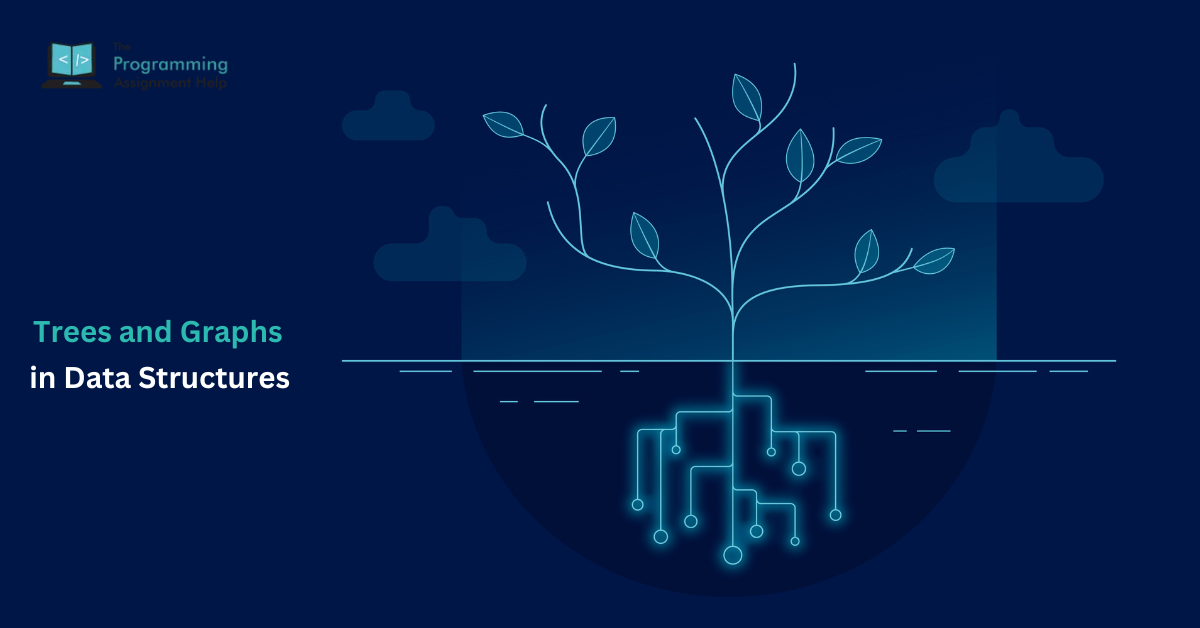
- 16th Sep 2025
- 23:10 pm
- Admin
Data structures are at the heart of computer science, helping us organize and process information efficiently. Among them, trees and graphs are two of the most widely used non-linear data structures. Both offer distinct methods of expression of relationships in data and have been vital in fields like databases, networking, operating systems and more algorithm design.
The blog discusses concepts and trees and graphs, properties, algorithms, and applications of trees and graphs, which provides students with a clear vision of the locations and reasons these structures are important.
Trees in Data Structures
Trees are hierarchical structures that arrange data as parent-child relationship making them effective in search and decision making.
What is a Tree?
A tree is a hierarchical data structure, in which the nodes are connected by the edge. It begins with a special node known as the root where all other nodes are branched out. Compared to linear data structures, such as array or linked list, trees give us the ability to model relationships of hierarchies, e.g. organizational structure or file systems.
Properties of Trees
It is important to learn the key features of trees in order to learn their structure and efficiency.
- Root node: The topmost node of the tree.
- Parent and child nodes: Nodes directly connected above and below.
- Leaf nodes: Nodes with no children.
- Height of a tree: The length of the longest path from the root to a leaf.
- Subtree: A section of a tree that itself forms a valid tree.
Common Types of Trees
There are numerous forms of trees used depending on the problem among them simple binary trees and advanced balanced trees.
- Binary Tree: Each node has at most two children (left and right).
- Binary Search Tree (BST): A binary tree where the left child is smaller, and the right child is larger than the parent node.
- AVL Tree: A self-balancing binary search tree.
- Heap: A special tree-based structure used in priority queues.
- Trie (Prefix Tree): Efficient for storing and searching strings.
Tree Traversal Algorithms
Traversal algorithms allow us to systematically visit all nodes in a tree to perform operations like searching or printing.
- Inorder (Left → Root → Right): Used in BSTs to retrieve sorted data.
- Preorder (Root → Left → Right): Helpful in creating copies of trees.
- Postorder (Left → Right → Root): Useful in deleting or freeing nodes.
- Level-order Traversal: Uses a queue to process nodes level by level.
Applications of Trees
Trees are widely applied in computer systems, from databases to machine learning.
- File system hierarchy in operating systems.
- Databases for indexing (e.g., B-trees in relational databases).
- Decision trees in machine learning.
- Parsing expressions in compilers.
Graphs in Data Structures
Graphs are mathematical expressions of relationships between entities, and hence are suitable to indicate networks, connections, and routes.
What is a Graph?
A graph is a data structure where it comprises of nodes otherwise referred to as verteces and a connection between these verteces, which is represented as edges. Compared to trees, graphs are more flexible because they can represent hierarchical as well as non-hierarchal relationships.
Properties of Graphs
The most important graph properties define the connection, direction, and traversal of data.
- Directed vs Undirected: Edges may have a direction or be bidirectional.
- Weighted vs Unweighted: Edges may carry weights (like distance, cost, or time).
- Degree of a vertex: Number of edges connected to a node.
- Path and cycle: A sequence of edges is called a path; a cycle is given when the path ends up at the node of origin.
Common Types of Graphs
There are a wide variety of graphs and each can be employed in a given use case like a navigation or dependency model.
- Directed Graph (Digraph): Edges have a direction.
- Undirected Graph: Edges do not have direction.
- Weighted Graph: Each edge carries a weight.
- Cyclic and Acyclic Graphs: Depending on whether cycles exist.
- Tree as a Graph: Every tree is technically a special kind of graph (acyclic and connected).
Graph Traversal Algorithms
Traversal algorithms such as BFS and DFS are useful in analyzing and processing the data in graphs.
Two popular techniques are used for exploring graphs:
- Breadth-First Search (BFS): This algorithm goes through nodes on a level by level, beginning with the source, and usually a queue is used. It particularly comes in handy when searching the shortest route in non-weighted graphs.
- Depth-First Search (DFS): That is a technique that examines a graph as far as possible in one branch of a graph then reverses. It is implemented normally using recursion or a stack.
Other important graph algorithms include:
- Dijkstra’s Algorithm: Finds the shortest path in weighted graphs.
- Bellman-Ford Algorithm: Handles graphs with negative weights.
- Kruskal’s and Prim’s Algorithms: Construct minimum spanning trees.
Applications of Graphs
From social networks to GPS navigation, graphs power many modern systems.
- Social networks: Representing users and their connections.
- Navigation systems: GPS applications rely on shortest path algorithms.
- Computer networks: Routers and data flow are modeled using graphs.
- Project planning: Directed acyclic graphs (DAGs) help in task scheduling.
Trees vs Graphs: Key Differences
Despite the fact that trees are a special form of graph, some major differences do exist between the two structures that influence their usage.
Structure:
- Trees are hierarchical and always begin with a root node.
- Graphs are more general and can have multiple connections without a strict hierarchy.
Connectivity:
- In trees, there is exactly one unique path between any two nodes.
- In graphs, multiple paths may exist between two vertices.
Cycles:
- Trees cannot contain cycles.
- Graphs can contain cycles, depending on their type.
Applications:
- Trees are widely used in file systems, databases, and decision-making models.
- Graphs are essential in computer networks, routing, social connections, and shortest-path problems.
Conclusion
Trees and graphs are the basic concepts of computer science, which allow organizing information, searching, and solving problems efficiently. The trees are used to depict hierarchy structures, whereas on graphs get influenced to enable modeling of complex relationships.
Students who have to deal with difficult tasks that involve these structures, need to have a good understanding of their properties, algorithms and applications. Professional Data Structure Assignment Help can give you further guidance, examples, and solutions on making Data Structure Assignment with you needs, and academic requirements, and explain them.








